Learn about the top skinny-fat workout and diet mistakes that I made during the first 3 years of my training.
When I started training during my late teenage years, I was a tall and lanky skinny-fat guy with terrible starting strength levels.
At 6’2″ height and 200 pounds of bodyweight, I remember attempting my first shoulder press.
I started out with an empty olympic barbell (45 pounds) and to my surprise I couldn’t do a single rep.
As a result, I started looking around all the popular fitness forums for training and diet advice.
I read everything I could get my hands on and studied those who had made a body-transformation happen.
After a few months of research, I decided to follow the conventional training advice of a linear progression training program that focuses on the big lifts (squat, bench press, deadlift, row and overhead press).
In my first year of training, I didn’t skip a single training session and added over 500 pounds to my squat, bench press and deadlift total.
I did all of this while following a high protein diet and maintaining my bodyweight.
Despite all my hard work, I didn’t get the results I looked for.
After 2 years of hard training and dieting, I didn’t look any different.
Here’s a progress picture showing my first 2 years of training progress:
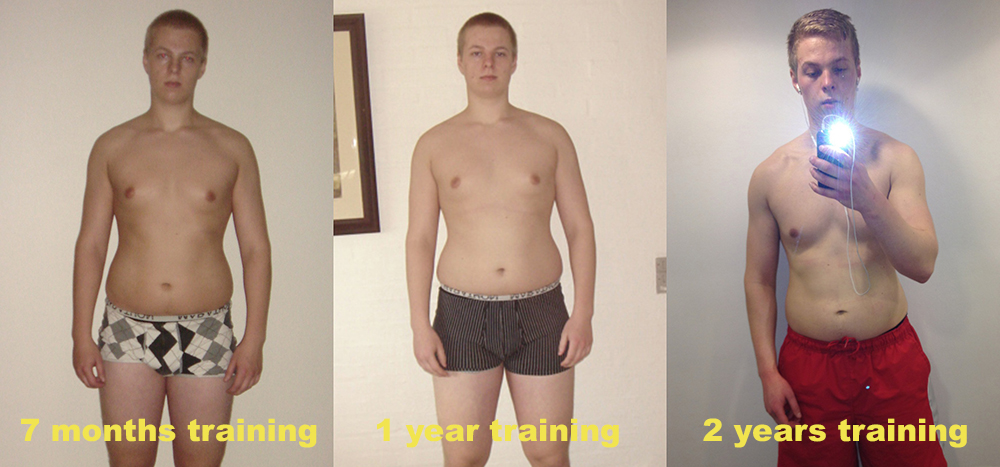
I put in all this hard work, but I had nothing to show for it.
As a result, I spent the next 2 years reading forums, blogs and experimenting with different training and diet methods.
I became obsessed with transforming my physique because I knew that in order to live my life to the fullest, I had to become comfortable with the way my body looks.
I tried various types of intermittent fasting, the KETO diet, 5 split bodybuilding programs, high intensity training, bodyweight training and anything else you can think of.
Most of it didn’t work but some of it worked.
After years of experimentation and training I finally found what works for the skinny-fat body-type.
I eventually used my training and diet strategies to lose 60 pounds of body-fat and gain 40 pounds of muscle mass in the right places.
In this article, I will share the 28 biggest skinny-fat workout and diet myths that prevent you from making optimal progress.
After reading this article, you will save years of wasted effort following fitness advice that simply doesn’t work for us skinny-fat guys.
By the way, the article is over 50 pages, therefore be sure to save the link for later reading if you don’t have time to read it now.
Let’s get started:
1) 5×5 Barbell Training Is The Best Skinny-Fat Workout
The most popular resistance training programs that I see skinny-fat guys follow are StrongLifts 5×5 and Starting Strength.
These are both based on using progressive overload to increase your 5 rep max.
Following 5×5 type training programs can produce muscle gains, but it’s not optimal for skinny-fat guys.
When you lift heavy in the 1-5 rep range, you become stronger because of Central Nervous System (CNS) adaptations.
The best way to understand CNS adaptations is to think of speakers.
If your muscles are the speakers, then your CNS is the amplifier.
By improving your CNS response, you amplify your existing muscles and thereby you can get lift more weight.
In other words, you teach your body how to become more efficient with the muscle mass it already has.
If your main goal is to increase muscle mass, you need to do the opposite and focus on primarily training the muscles instead of the CNS.
This is done through higher reps because higher reps enable you to practice better technique and get a longer time-under-tension.
Both which are key to maximise muscle gains.
2) Use Cardio to Get Lean
Cardio is a great tool to improve your health, however it should always come second to resistance training.
Resistance training builds muscle mass and the more muscle mass you have, the faster your metabolism becomes.
The key here is the increase in metabolism.
You always want to prioritise increases in metabolism over burning Calories.
By increasing your metabolism, you will be able to eat more food once you get lean.
So instead of having 4 meals per day, you may be able to get away with 5 or 6 meals per day while staying lean.
A good example of this is my client Francis from my post Increasing Calories Can Help You Lose Fat If Your Metabolism Is Slow.
Francis is 37 years old and trains just 30-40 minutes per day from home.
When he joined my Online Transformation Program For Skinny-Fat Guys, he had already lost some body-fat, however he was stuck and couldn’t get leaner.
He thought that he had to reduce food intake to lose body fat but it was actually the opposite… he was undereating with his Calories being way below his estimated Daily Caloric Expenditure.
This of course resulted in his metabolism slowing down.
As a result, we decided on creating a diet plan that had a higher food intake than he was used to and the result was that the he was able to build muscle mass while simultaneously losing body-fat.
All his muscle measurements increased (chest, shoulders, arms) while hips and waist decreased with a total of ~6 inches.
Chin ups increased from 4 to 14 with form becoming cleaner and diamond push ups are up to 34 clean reps on the first set.
After 10 weeks he made great progress:
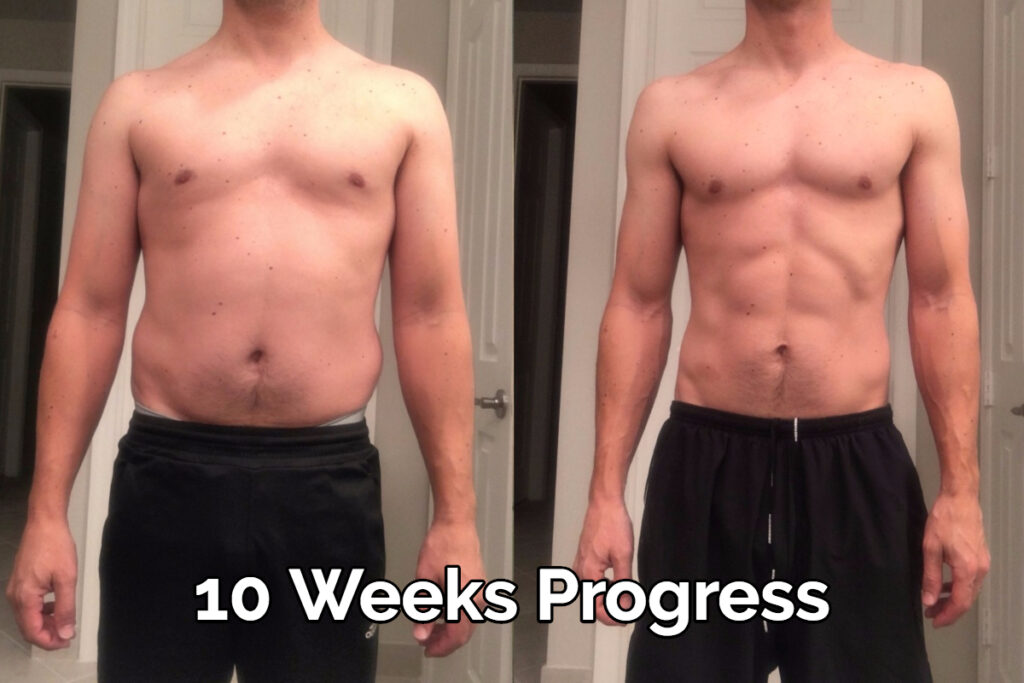
You see… The key to sustainable fat loss is not to cut food intake overnight or do more cardio because that will just make you lose muscle and slow down your metabolism.
You want to use the diet and training strategy that allows you to eat the most amount of food while still losing fat – even if that means losing weight at a slower rate.
When you do so, your diet will maintain metabolically precious muscle mass and if your training is on point you will even build muscle mass.
The more muscle mass you have, the faster your metabolism becomes.
With a faster metabolism you will burn more fat at rest and thereby you’ll be able to eat more food while staying lean.
You will also maintain a high natural testosterone production and feel a lot better throughout the whole diet process.
In other words, a faster metabolism will make it much easier to stay lean long-term.
3) Isolation Exercises Are A Waste of Time
You will often see that a minimalistic routine of heavy squats, bench presses, row and deadlifts is recommended to skinny-fat guys.
The argument is that these compound lifts will develop your entire body.
And that is mostly true.
Here are the muscle-groups trained with each exercise:
- Squat: Quads, hamstrings, glutes.
- Deadlift: Lower back, traps, hamstrings.
- Row: Upper back, biceps.
- Bench Press: Chest, triceps, front shoulders.
(The abs and forearms are used as stabilisers on all the exercises).
When you look at the muscle groups trained with these compound exercises, you will see that most of the body is covered.
However, that doesn’t mean that most of your body will get equal development.
When you perform heavy compound exercises, your strongest muscle groups will take over and get the most development. (The heavier the weight, the more this is true).
For skinny-fat guys, this most often means that the thighs, glutes and lower chest get overdeveloped.
These are the muscles that make you look more “bulky” and essentially they will make you a bigger version of your current self.
If you want to improve your aesthetics, you need to focus on training the muscles that improve your proportions instead of becoming a bigger version of your current self.
4) Train for Maximum Size Instead of Proportions
The single thing that will make the biggest difference to your physique is improving the shoulder-to-waist ratio (or building the V-taper).
Most skinny-fat guys start training with a shoulder-to-waist ratio that is somewhere between 1.1-1.2.
This means that the shoulder circumference is 1.1-1.2 times bigger than the waist circumference.
This is far from ideal because the ideal shoulder-to-waist ratio is 1.618.
1.618 is known as the golden ratio of aesthetics.
It’s the ratio used to design many buildings and sculptures.
Having shoulders that are 1.618 times bigger than your waist will give you that V-tapered look on your torso and maximise your aesthetics.
For example if your waist is 80 CM when you’re lean, you want your shoulders to be 129 CM.
The good thing is that nearly everyone can achieve a shoulder-to-waist ratio of 1.5-1.7.
I personally had what you would consider some of the worst starting proportions for achieving the ideal shoulder-to-waist ratio.
My shoulder bones are narrow while my hips and waist are wide.
After 4 years of training, I added more than 10 inches to my shoulder circumference and my shoulders became almost 1.6 times the size of my waist:
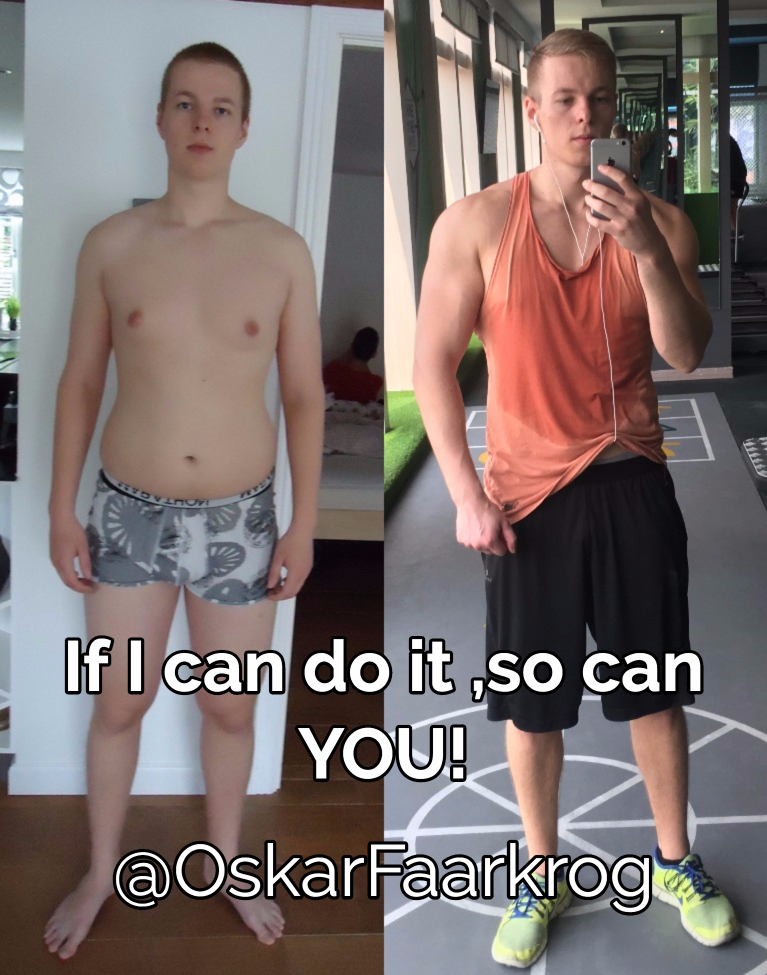
I did this by prioritising certain muscle groups and exercises.
I focused on developing the lats, shoulders, upper back and upper chest.
I hit all of these muscle groups from different angles to get full development.
For example, the shoulder consists of 3 heads (rear, lateral and anterior), therefore you need at least 3 exercises to get fully developed shoulders.
And the lats are the muscle group that takes up the most space on your body and they consist of the lower and upper part.
For the lats, I personally found that I get great development from just doing chin ups, but by adding more exercises I can take them to the next level.
Overall, I needed a big variety of exercises and high volume training to fully sculpt these muscles.
This again shows why minimalistic training isn’t optimal if your goal is to build a physique that stands out.
With minimalistic training programs you simply don’t have enough exercises to fully stimulate all muscle fibres in a given muscle.
5) Your Shoulder Width Comes From Well-Developed Shoulders
When people want to improve their shoulder-to-waist ratio, they often make the mistake of focusing all their effort on training their shoulders.
While the shoulders are important, they contribute less to your shoulder width than your lats.
Your lats are a much bigger muscle group and when trained properly, they can grow very wide:
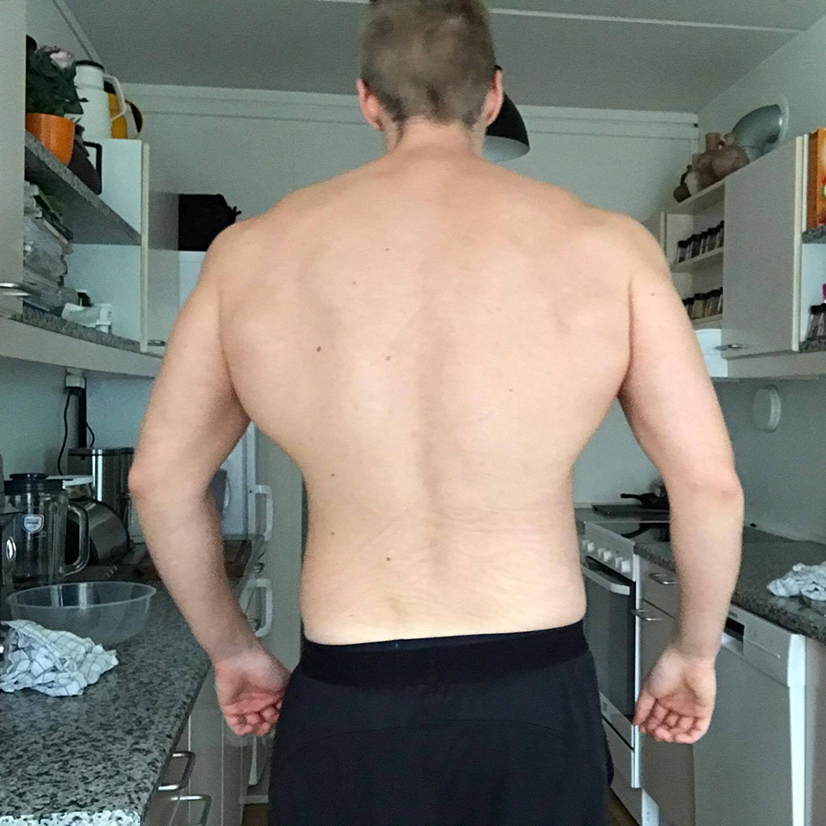
Well-developed lats will get so wide that they push your arms out to the sides and broaden your entire torso.
If I hadn’t built my lats, I would never have gotten close to the ideal shoulder-to-waist ratio.
There’s only so much size you can add to the shoulders, therefore you have to focus on maximising the size of your lats.
The best exercise for developing the lats is the chin up which is the main exercise in my bodyweight program for skinny-fat guys.
You want to build up your strength to do 20 clean chin ups and then move on to achieve weighted chin ups with ~100 pounds attached.
You can see more good exercises for the lats in my training video below:
6) Optimal Shoulder Training Consists of Shoulder Presses, Lateral Raises and Shrugs
While the lats are more important than the shoulders, you don’t want to neglect your shoulder training.
Round and capped shoulders will give you an extra inch or two to your shoulder measurement and make your physique look much more complete.
The problem with the shoulders is that if you aren’t genetically gifted in that area, they’re one of the most difficult muscle groups to develop.
One good way to know if you are genetically gifted in the shoulder area is to look at your pressing strength and body-structure.
If you make fast progress on pressing movements such as the overhead press and your shoulders grow from doing pressing movements alone, you have great genetics for shoulder training.
Most often the guys that fall into this category are shorter guys below 6 feet height who have a stocky and wide shouldered build with short arms.
For the rest of us, the only way we can get fully developed shoulders is by training them often, with a lot of volume and doing isolation work.
The shoulders have 3 heads: Front, lateral and rear.
The most important part here are the rear shoulders:
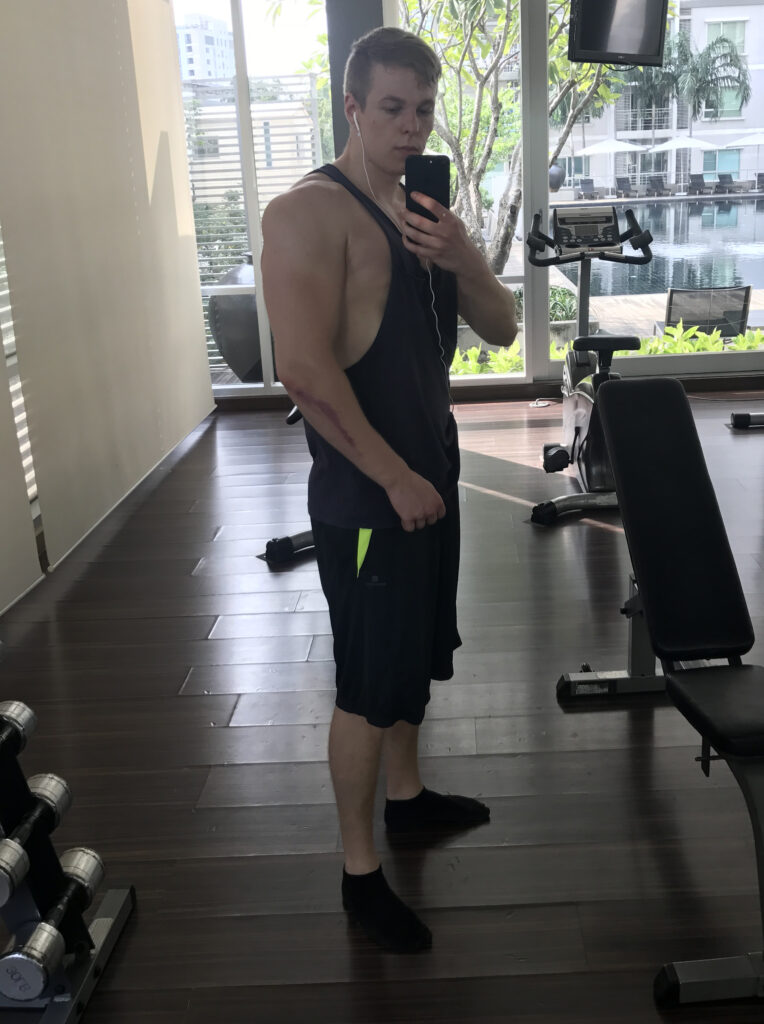
The rear shoulders make your shoulders look bigger from the front, side and back and they have the most potential for “easy growth”.
What do I mean with easy growth?
When you look at the average fitness guy, he will have front and lateral shoulders that are way more developed than the average guy that doesn’t train.
However, when you look at his rear shoulders, they will look the same as someone who has never touched a weight.
I recall reading a study done on bodybuilder that showed that bodybuilders have way bigger front and lateral shoulders but the rear shoulders are just ~15% bigger than the average person.
This means there’s a lot of room for development in the rear shoulders.
The rear shoulders are unique in the way that they are a pulling muscle, yet the get almost no stimulation from any of the big pulling exercises such as rows, deadlifts, pull ups and lat pulldowns.
As a result, most guys who start training rear shoulders will start off with tiny weights regardless of how much they can lift and how long time they have trained.
I personally started with using 5 pound dumbbells on dumbbell reverse flyes and I’ve had Online Transformation Program clients do reverse flyes with just their arms alone.
The good thing here is that once you strengthen the rear shoulders, they grow fast and you will see a great increase in your overall shoulder size.
In addition to improving aesthetics, well developed rear shoulders will improve your posture by pulling back your shoulders.
This prevents the common shoulders injuries most people get and more importantly: Better shoulder posture will make you appear wider from the front by exposing your lat development!
7) A Few Sets of Curls and Extensions At the End of Your Training Will Give You Big Arms
Most skinny-fat guys limit their arm training to just “biceps and triceps”.
So they throw in a few sets of biceps curls followed by a few sets of triceps extensions.
This will work if you are a complete beginner or have an easy time building up your arms.
But it won’t work for maximising your arm size.
To understand why, you need to look at the structure of the biceps and triceps.
The biceps has 3 parts that need to be trained:
- Inner head.
- Outer head (biceps peak).
- Brachialis which runs from the forearm and under the biceps muscle. It pushes up the biceps and adds bulk to it.
Each head can be emphasised with different curling variations.
Now, let’s take a look at the triceps which has three parts that need to be trained as well:
- Long head.
- Lateral head.
- Medial head.
Again, each head can be emphasised with different triceps exercises.
To fully develop all 6 heads to their maximum potential, you need to do a minimum of 6 exercises.
I personally have 12 exercises for the arms: 6 exercises for the biceps and 6 for the triceps.
I make sure to hit each exercise at least 1-2 times per week with high volume and intensity.
Adding exercise variety, training arms more often, going hard and doing a lot of volume has helped me transform my arms from being long and lanky to being one of my best body-parts that people often comment on.
When I started training all heads of the biceps and triceps, I saw a 2 inch increase in my arm measurement within 1 year of training.
Therefore my advice is that you don’t limit yourself to just a few sets of curls and extensions.
You need high volume, angles, high frequency, a variety of rep ranges and specific exercises for each head for full development.
8) The Bodybuilding 5-Split Is Optimal For Muscle Gains
Whenever you read an interview with a fitness model or bodybuilder, +90% of them will be on a classical split routine that goes something like this:
- Chest
- Back
- Arms
- Legs
- Shoulders
It’s the worst training structure you can follow and now I’ll give you the #1 reason to why that is the case.
With a 5 split set-up you’re only training each muscle once per week.
This is not ideal because nearly all studies show that the optimal training frequency for muscle growth is 2-4 times per week.
Why? Because protein synthesis only lasts 28-48 hours.
This means that for 28-48 hours after a hard training session, your muscles are broken down and repairing.
After that, they are ready to get stimulated again.
As a result, you’re leaving a lot of muscle gains on the table by training each muscle once per week.
The guys who get results on 5-splits are most often steroid users, complete beginners or have great genetics.
They get results in spite of their training. Not because of it.
9) The Barbell Bench Press Is A Great Chest Exercise
In most chest training programs, the barbell bench press is a staple.
It’s universally known as a great chest builder and you will see everyone doing it on Mondays which is “national chest day”.
The issue with the barbell bench press is that it trains the lower and center part of the chest.
As a result, your chest get’s a sagging and feminine appearance like most modern bodybuilders have.
In addition to making your chest look feminine and saggy, your shoulders and arms will appear a lot smaller when your chest is overdeveloped (especially from the side).
So how do you build a masculine looking chest that is in proportion?
Focus on the upper chest.
It’s a well-developed upper chest that pops out and gives your chest a squared and masculine look:
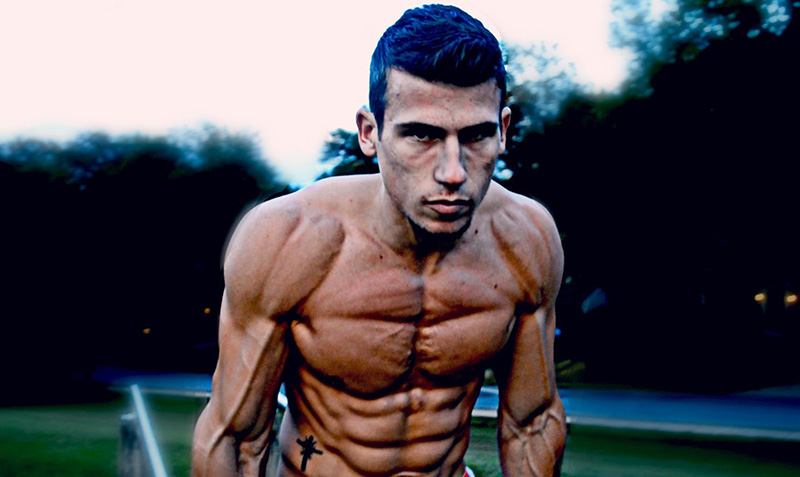
The great thing about focusing on training the upper chest is that it’s a relatively small muscle group, therefore by training only the upper chest, you automatically keep your chest in proportion with the rest of your body.
The upper chest is best developed by doing the following exercises:
- Low cable flyes.
- Handstand push ups.
- Overhead presses.
- Incline bench presses. (Barbell, dumbbell, machine).
- Incline dumbbell flyes.
- Incline dumbbell pullovers.
- Diamond push ups.
The key to develop the upper chest is to use lighter weights and build up your mind-muscle connection.
The mind-muscle connection is incredibly important for the upper chest because it’s a small muscle group and the muscle fibres in the upper part of the chest are extremely hard to target.
If you make the mistake of maxing out on upper chest exercises, your lower chest (which is much stronger) will take over and you won’t see any upper chest development.
Therefore, take my advice and use light-moderate weights that you can fully control.
Your goal should be to make the light weight feel heavy on every single rep.
This is done by using as much upper chest as possible while minimising the involvement of big muscle groups such as the lower chest and shoulders.
So you may be able to max out 150 pounds on an incline bench press, however after you work on the mind-muscle connection you are getting an effective workout with just 50-75 pounds.
I discuss upper chest training more in-depth in my video below:
10) You Need To Train Your Legs Hard and Heavy Like A Powerlifter or Pro Bodybuilder
It’s common that a lot of you fall for the trap of training legs like modern bodybuilders or powerlifters.
This means that you either dedicate 1-2 full training sessions per week to high volume leg training (modern bodybuilder) or have 2-3 heavy squat training sessions per week (powerlifter).
Doing either of these are not ideal for skinny-fat guys because of 2 reasons:
- V-Taper vs. X-Taper: Big legs take away from the size you add to your shoulders and lats. Instead of getting a V-taper like most hollywood action stars, you will get an X-taper like modern bodybuilders and strength athletes.
- Limited Energy: Heavy barbell squats and deadlift variations are very demanding on your recovery. By training your legs first in your training like a powerlifter, you leave less energy for developing your lats, shoulders, upper chest and arms.
The better way to go about leg training is to look at the way the classical bodybuilder Steve Reeves did it.
He trained full body 3 times per week, but he did just 8 sets for legs at the end of his training sessions.
By doing so, he was able to focus on maximising his upper body size while keeping his legs strong and in proportion to his upper body:
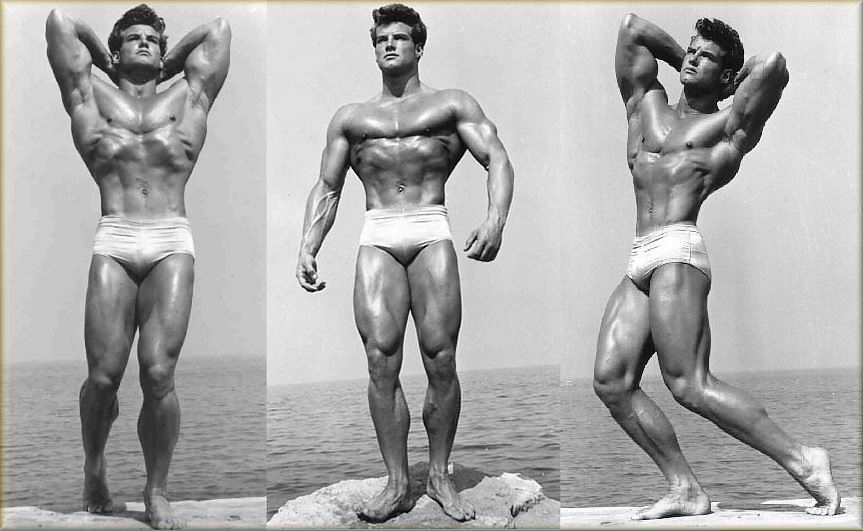
For most skinny-fat guys, this will be the better approach because most of us have upper bodies that respond slowly to training when compared to our lower body.
11) Skinny-Fat Guys Can’t Get Big Without Getting Strong
When I started training, I was sold on the belief that I need to hit a certain strength standard to look great.
Examples:
- You need to bench press 315 pounds to have a great chest.
- You need to overhead press 225 pounds to have big shoulders.
- You need to squat 400 pounds to have big legs.
Most of us have tiny wrists and ankles.
And this is a big problem because your bone-mass is the greatest indicator of:
- Starting strength levels: How much can you bench press, squat and deadlift the first time you touch a barbell?
- Starting muscle levels: The amount of muscle mass you carry before doing any training.
- Strength response to training: How fast you gain strength on a good program.
- Muscle response to training: How fast you add muscle mass.
- Strength limit: What is your genetic limit strength? How strong can you get after 10-20 years of consistent weight training?
- Muscle limit: What your genetic muscle limit? How muscular can you get after 10-20 years of consistent weight training?
As a result, most skinny-fat guys have low starting strength levels and we don’t respond well to heavy weight training.
After 6-12 months of weight training, those of you of you who trained hard on good program will have lifts that are somewhere in the intermediate stages:
- 200-240 pound bench press.
- 280-315 pound squat.
- 350-400 pound deadlift.
I put different ranges for each lift because the amount of weight you can lift on each of them will depend on your bodyweight and leverages.
For example, tall and lanky guys with long arms will have great leverages for the deadlifts therefore we tend to do well with deadlifts and reach 400 pounds while shorter guys with short arms and legs will do great on bench presses and squats.
After you’ve tapped out your beginner-early intermediate gains, it becomes very hard to add strength to your big compound lifts unless you eat a massive amount of Calories to add body-fat.
As a result, you can choose to gain more muscle mass but with more body-fat… or stay the same.
So the question is: How can a skinny-fat guy with decent strength levels develop the musculature of someone who is much stronger?
This is the big question that I’ve spent years answering and I got the answer for you:
We can use training frequency and volume to compensate for a lack of total strength.
By training more often, using a bigger variety of exercises and doing a lot of sets, we can get similar muscle development to a guy who is much stronger.
I personally don’t have huge lifting numbers and my strength has barely increased the last 4 years.
However, I have much more muscle mass today than 4 years ago.
All my measurements (shoulders, chest, arms) have gone way up.
All these increases have happened without increasing my maxes on any of the big compound lifts.
I showed some of my training and progress in my post 68 Days of Massive Upper Body Muscle Gains.
In my personal experience, you can build a similar level of musculature as someone who is much stronger than you, but you will have to put more time into training.
To be specific, you have to:
- Increase Frequency: Train each muscle group to failure more often. (3-5 times per week).
- Increase Variety: Use a bigger variety of exercises to stimulate more muscle fibres.
- Increase Volume: Do more total sets per week for each muscle group.
- Increase Intensity: Use drop-sets and rest-pause sets to increase the intensity of your training without using a bigger load.
- Use Circuits: Combine 3-5 exercises into a circuit and do them back-to-back. This has a strong metabolic and muscle building effect.
When you do all these things, you can compensate for a lack of load.
So you may only be able to bench press 220 pounds but have the chest development of someone who is working with 280-315 pounds.
12) You Will Build Muscle Mass As Long As You Train Hard (But Not Smart)
Recently, I started working with a skinny-fat guy who trained hard for years, yet he had no strength base.
After 2 years of training he struggled completing 5 chin ups.
I then looked at his training history and it was clear to me that he had didn’t follow a proper training program.
He just went to the gym 5 times per week and did a 5-split bodybuilding program:
- Monday: CHEST
- Tuesday: BACK
- Wednesday: LEGS
- Thursday: SHOULDERS
- Friday: ARMS
- Saturday: OFF
- Sunday: OFF
Each time he would train a variety of exercises until exhaustion, but he never focused on progressive overload.
While I’m all about using angles, frequency, volume and drop-sets to increase your muscle mass, these things come later.
In the first 6-12 months of training, you need to focus on building your strength base, ideally in the higher rep ranges so you also get some good muscle gains.
For example, if you did 60 KG on the shoulder press for 10 reps in your last training session, you want to try doing 62.5 KG or more in your next session.
If you continue doing a bit more each training session, you will build more muscle mass over time.
Just imagine going from a 15 KG shoulder press to a 70 KG shoulder press.
Your shoulders and triceps will inevitably grow from the stimulus.
Doing more work over time is the driver behind muscle growth.
As a result, a proper training program must have a progressive overload strategy for at least a few key exercises (e.g. dumbbell row and shoulder press).
You can’t just go in and wing your training sessions because then you will end up doing the same work-load over and over again… and see minimal changes in your musculature.
All the stuff I mentioned above with variety, angles, circuits, drop-sets and rest-pause sets comes after you have a solid foundation of strength.
The key take away: Unless you’ve already built the muscle mass you want to build, you need to go into each training session with a clear goal of how much you will lift on certain exercises. That amount needs to exceed your previous max on a regular basis. This is how you make progress and gain muscle mass.
13) Perfect Form Leads to Maximum Muscle Gains
While I preach perfect form a lot on my website, the truth is that some strategic cheating will give you smoother progress.
I didn’t go from 0 chin ups to doing weighted chin ups with 100 pounds by using perfect form all the time.
I strategically used cheat reps to stimulate progress.
Cheat reps will help you progress faster and eventually you will be able to do more reps and weight without using cheat reps.
For example, if you start at 2 chin ups and you use momentum and swinging to get to 15 chin ups, you will most likely be able to do anywhere from 7-9 chin ups with perfect form after.
The key is to get the progression benefits of cheat reps while staying injury free.
When I get my Online Transformation Program clients started on a resistance program, my default advice is that they have to use perfect technique on every rep to minimise risk of injury.
Good technique ensures that you develop all your muscles while minimising the risk of injury.
If you can make consistent progress using perfect form on every set and every rep, continue doing so.
There’s no reason to take on any injury risk if you’re making progress just fine training with clean reps.
With that said, there are some skinny-fat guys who can’t make consistent progress using good form.
It’s most often those of you who are low responders to training or tall guys with very low starting strength levels and small bone-structures.
In my experience, cheat reps are the only way that true low responders can achieve progressive overload in their training.
We need that extra push to stimulate progress.
Using the chin up as an example, there are three ways to use cheat reps:
- Cutting down on range-of-motion. Example: Only going half-way down on chin ups.
- Using momentum. Example: You drop yourself from the top position of the chin up, then “bounce” out of the bottom. By dropping yourself and bouncing out of the bottom, you create momentum which makes the next rep much easier.
- Swinging. Example: You kick your legs up to your chest on chin ups to generate extra force.
The more you cut range-of-motion and the more momentum and swinging you use, the easier each rep becomes.
Your muscles do less work and you put more stress on the joints.
When you use cheat reps, you are increasing your risk of injury in exchange for faster progress.
As a result, you need to use cheat reps intelligently.
You want to use the minimum dose required to stimulate progress.
Here are the 5 rules of using cheat reps that will help you stay injury free:
- Don’t use cheat reps if you’ve previously been injured. It’s not worth the risk.
- Only use cheat reps if you can’t progress consistently with clean form.
- Only use cheat reps on the FIRST set of your main exercises. The first set is the most important for achieving progressive overload since you are fresh and you have the highest likelihood of beating your old max.
- Use the minimum dose required. If you can stimulate progress with just a bit of momentum and swinging on the last 1-2 reps, then that’s all you should do.
- Don’t push through pain. If you start feeling any joint pain, don’t keep pushing through it. There will be some days where your body simply can’t handle cheat reps, so you have to drop your ego and listen to your body.
Also, remember that the end goal of cheat reps is to eventually be able to do more weight with good form.
This requires that you do most of your training with good form and only use cheat reps sparingly.
If you’re always using cheat reps (like most people do), you will lose out on a lot of strength and muscle development.
14) High Volume Training Only Works For Enhanced Bodybuilders
After frequenting gyms for over 7 years, I’ve noticed that the most built guys have the following thing in common: They all go to the gym often and they train with high volume.
They do a variety of exercises for each muscle group and train with a variety of rep ranges.
The main benefit of high volume training and a bigger exercise variation is that you stimulate more muscle fibres.
Over time, this leads to more muscle size – especially in the muscle groups that you find hard to grow.
I used the examples earlier of the shoulders and arms.
These used to be two muscle groups that I could never grow.
After 2 years of hard and heavy training, I still had small arms and non-existent shoulders.
Then I started doing high volume training for both.
I experimented with a variety of exercises and eventually found out how I can stimulate all muscle fibres in both of these muscle groups.
Then I did one more thing: I increased training frequency.
Instead of limiting myself to one high volume day per week, I gradually built up to training my arms and shoulders 4-5 times per week with high volume.
The result? My shoulders and arms are no longer weak-points. They are now my best muscle groups together with my lats.
Most people overestimate what they can achieve in their first year of training, but they underestimate what they can achieve long-term.
The truth is that, high volume training is not something you want to start off with.
The risk of injury is high and you need a solid strength foundation to benefit from it.
But don’t limit yourself for the long-term.
There’s no reason to why you can’t build up your volume and frequency over the long-term.
15) The More You Train Your Abs, The Better They Become
Developing your abs means growing the ab muscles.
In other words, developed abs = a thicker waist.
A guy with a naturally small waist and wide shoulders can get away with this without any problems.
But if you’re a guy with a naturally wide waist, every inch off the waist counts.
Thickening the waist with ab training will add anywhere from 1-2 inches to your waist and take away from your shoulder-to-waist ratio.
When I start training my abs too much, I start looking fat in a shirt because I add a lot of muscle mass all over my waist.
This makes my mid-section look bloated and when I put on a shirt I start looking stocky instead of V-tapered.
Does that mean that you should completely stop training the abs if you have a naturally wide waist or wide hips?
No, you have to find that sweet spot where you’re training your abs to the point where they get some muscle mass and definition but not so big that they push your waist out.
The sweet spot for me is to gently train the abs with a few easy sets of hanging leg raises a few times per week.
16) You Can’t Train For A Smaller Waist
A tiny waist improves your shoulder-to-waist ratio and dieting off body-fat is not your only tool in the arsenal.
I can tell you from personal experience that you can TRAIN for a smaller waist.
You can train to expand your rib-cage and make your waist smaller.
The way you do this is by doing dumbbell pullovers:
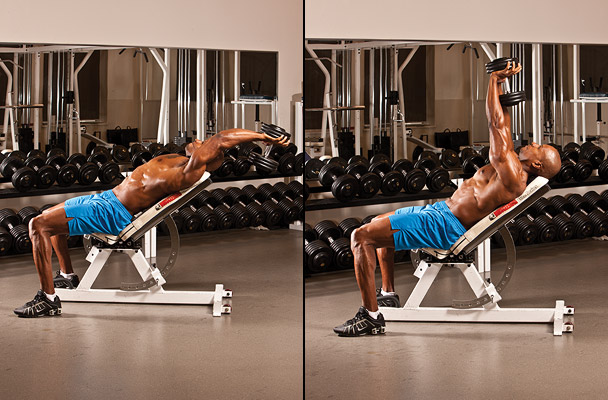
Dumbbell pullovers are the upper body equivalent of the squat.
They train your entire upper body, expand your rib-cage and make your waist smaller.
The keys to get the most benefits out of the pullover are:
- Suck in your stomach on each rep and hold your breath. Only breathe after completing a rep.
- Do them from an incline to get the dual benefit of making your waist smaller while increasing upper chest size.
- Do them at least 4 times per week at the end of your training. 5-8 sets each time.
- Use a short rest-time between sets. 20-30 seconds.
- Lower the weight if needed and vary the rep ranges.
If you do this, I can guarantee you that your waist will appear smaller after just 3 weeks.
If you look at classical bodybuilders, you will see that they had tiny waists, big rib-cages and they could pull off the vacuum pose.
What did they all have in common? They did dumbbell pullovers and practiced the vacuum throughout the day.
17) Free Weights Are Always Superior to Machines and Cables
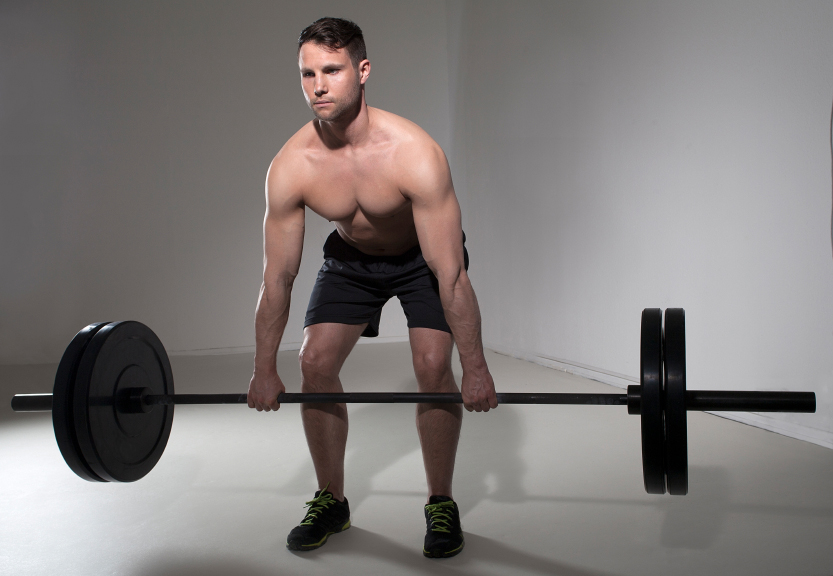
When you can choose between two similar exercises (e.g. a machine shoulder press and a barbell shoulder press) the free weight is most often promoted as the better option.
The reasoning goes that free weights activate more stabilising muscles and have a more natural movement pattern.
While this is true, there’s also a downside to free weights: They put more stress on your joints and take longer to recover from.
As a result, free weights will not always be ideal for weak muscle groups that need a lot of volume and frequency to grow.
For example, I’ve found that my triceps need an enormous amount of volume and frequency to grow.
I’m currently doing +100 isolation sets per week on various triceps pushdowns and extensions. (This is in addition to my dips, diamond push ups and shoulder presses).
I experimented with using free weights (dumbbell extensions and skullcrushers) for some of my triceps work, but after just a few weeks I started getting pain in the elbows.
If I kept pushing through this pain it would inevitably turn into pain and later a serious injury.
Using free weights have always better a limiting factor in my triceps growth because I was never able to use enough volume and frequency to grow them.
With cables, I never had this issue.
I can keep doing cable pushdowns and extensions all day long, every single day without any elbow aches or negative impact on recovery.
The conclusion? Be open to include machines and cables in your program. Don’t limit yourself to “functional training” and free weights because: 1) Cables and machines can increase your muscle mass and 2) All muscle mass is functional!
18) Bodyweight Exercises Are Useless During Bulking
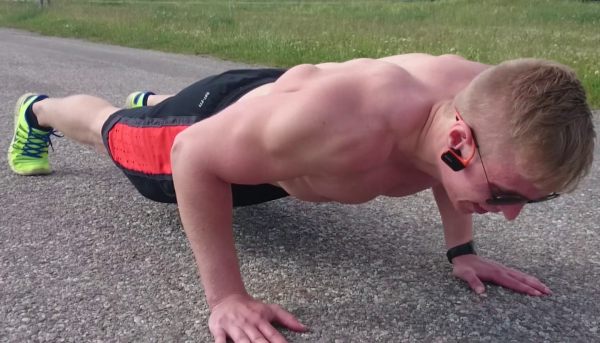
It’s important to start off your training career with mastering basic bodyweight exercises… and then include them in all your programs later on.
Why? Because they keep your body-composition in check.
If you bulk up from 150 pounds to 200 pounds and you maintain your ability to do 20 pull ups, it means two things:
- You’ve increased your strength.
- You added quality weight to your frame with a good amount of muscle mass and improvements in body-composition.
Now imagine if you go from 150 pounds to 200 pounds but your pull up max drops from 20 to 5.
Your body mass increased but you didn’t improve your body-composition.
This is the main reason to why you should always include bodyweight exercises in all your training programs.
Being skinny-fat, you have a very easy time gaining body-fat when you bulk up.
By always maintaining your strength on bodyweight exercises, you ensure that you see positive body-composition changes during your bulk.
19) You Can Spot-Reduce Fat By Doing Specific Exercises
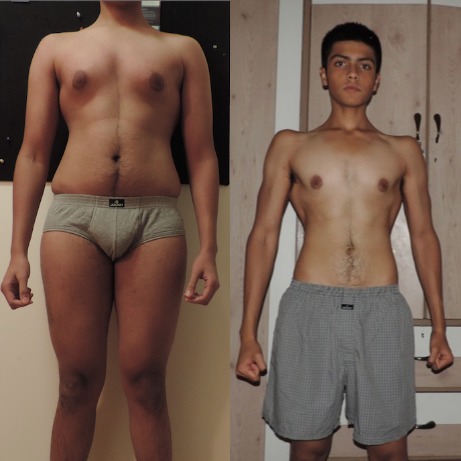
When you lose fat your body will determine where it will lose it first.
For most people this means that you will start losing body-fat in the place you gained it last.
E.g. if you gained body-fat on the arms, shoulders and back last, those will be the first places to go.
This presents a big problem for skinny-fat guys because most of us gain body-fat in the love handle area, hips and lower chest first.
In other words, you will most likely lose the fat on the love handles, hips and lower chest after you’ve lost the fat on the shoulders, arms and back.
As a result, you will look worse at the beginning of your fat loss process.
When you lose that extra layer of cushion on your arms, shoulders and back, it makes you look like you’re losing muscle mass on the upper body.
In the meanwhile, your love handles and hips remain the same, thereby making you look even more skinny-fat.
This is where a lot of skinny-fat guys make the mistake to stop their fat loss and increase food intake.
They freak out because they look worse compared to when they started.
This is especially the case for Indian and middle eastern skinny-fat guys who tend to store a lot of body-fat in the shoulders and arms.
The solution here is to stay patient with your fat loss.
It will take time before you start losing body-fat on the stomach, hips and chest if those were the places that you gained fat first.
There’s no practical way to spot reduce fat.
All you can do is follow a good fat loss protocol, stay patient and let the body do its work.
20) You Need To Be At A Certain Weight To Look Good
I often get emails from readers related to weight.
For example a skinny-fat guy who is 6 feet tall thinks he needs to be 190 pounds to look good because his lean friend who is 6 feet tall is 190 pounds.
There’s a big problem with this line of thinking and it’s related to bone-structure.
Skinny-fat guys usually have a small bone-structure (small wrists, ankles and neck).
By default, our skeletal structure weighs less.
This means that we will by default weigh less than most guys our height.
But here’s the good thing about having small bones: When you have small bones, you don’t need as much mass to look impressive.
16″ biceps look much bigger on a guy with tiny 5.5 inch wrists compared to on a guy with large 8 inch wrists.
As a result, you don’t need to add as much muscle mass and total bodyweight to look impressive.
You may only need to add a few inches to your arms, shoulders and chest to build some awesome proportions.
I know this because I’m 6’2″ tall with tiny wrists and my biceps are only 16″ flexed.
I always get complimented on my arm size because 16″ look big on my frame.
If you put the same 16″ inch arms on a guy with thick wrists, a large neck and naturally wide shoulders, they wouldn’t look impressive.
He might need to get to 18″ to look impressive.
Therefore, my advice is that you stop focusing so much on comparing yourself to other people and take your bone-structure into account.
If you have tiny wrists, ankles and neck you don’t need to add as much mass and total bodyweight to look your best.
21) A Low Calorie Diet Will Help You Achieve Sustainable Fat Loss
To lose fat you need to be in a Caloric deficit.
However, the biggest mistake you can make is to have an aggressive Calorie deficit.
An aggressive Calorie deficit will at first help you lose more weight, but there are many big downsides:
- Metabolism: Your metabolism will slow down. This means that you will need to cut food intake further to sustain fat loss.
- Hunger: When your food intake is already low and you have to cut food intake further to support fat loss, you will get unbearable levels of hunger.
- Loss of muscle mass: You will lose a lot of muscle mass and end up looking skinny and starved instead of lean.
- Low testosterone levels: Your natural testosterone production will decrease and you will see a huge drop in sex drive and sexual performance.
In other words, you are facing a terrible trade off.
You are getting 2-4 weeks of slightly quicker weight loss for unbearable levels of hunger, low energy levels, low sex drive, loss of muscle mass, a slowed down metabolism and low testosterone.
And worst of all, you will inevitably regain all the fat you lose because your willpower is limited.
You cannot sustain a low Calorie diet long-term because of the unbearable levels of hunger.
So when you regain all the weight you lost, you will have to restart the process again.
When you restart the process, you will be doing so with a slower metabolism and lower testosterone production.
This means that you will have to spend time optimising your metabolism and natural testosterone production.
For some people this can be 4 weeks.
For other people it may take a year or more to reset metabolism.
The time depends on how long you sustain a low Calorie diet and how sensitive your endocrine system is to the shock of a low Calorie diet.
The take-away lesson here is that you should never put quick weight loss over your metabolic and hormonal health.
The only way to achieve long-term fat loss is to put your health first and that means having a slight Caloric deficit, implementing re-feed meals and being patient.
22) You Need to Eat 1 Gram of Protein Per Pound of Bodyweight
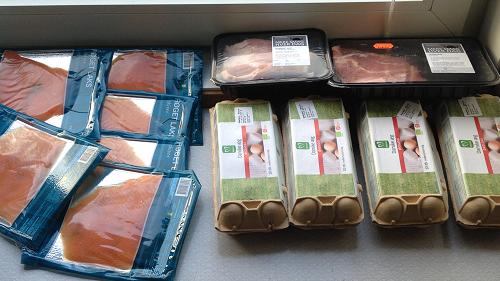
You will often read that you need 1 gram of protein per pound of bodyweight.
This means that a 200 pound guy needs 200 grams of protein.
This is the equivalent of 1 KG (450 grams) of chicken breast per day.
When you try hitting your protein target, you will likely find that you have to force-feed most of the protein.
And there’s a good reason for that: Your body doesn’t need 1 gram of protein per pound of bodyweight.
There’s not a single well-designed study showing that you need that much protein to build muscle mass.
The 1 gram of protein per pound of bodyweight recommendation is made to sell more protein powder supplements.
The supplement industry is a billion dollar industry and the best-selling product is protein powder.
Supplement companies know that people will find it difficult (and expensive) to achieve their target protein intake by eating lean cuts of meat.
As a result, people resort to buying protein powder every single month (recurring revenue for supplement companies once they got you hooked).
A more sensible protein guideline is 0.7 grams of protein per pound of lean body mass.
This means that if you’re a 200 pound guy at 15% body-fat, you need around 120 grams of protein per day.
I’ve personally followed this guideline for over 4 years and all my muscle measurements have increased more compared to when I ate +200 grams of protein per day.
Why? Because I’m able to get in more protein sparing nutrients (carbs and fats).
By eating 100 grams of protein per day instead of 200, I have an extra 400 Calories to allocate to carbs and fats.
Going higher in carbs and fats while staying at the same level of Calories will give you much more energy and enable you to have tastier, more balanced meals.
These things increase your chances of adhering to your diet long-term and thereby keeping your results long-term.
23) It’s Important That You Eat Protein Every 3 Hours
Another protein myth is related to timing.
You will often see claims that you need to consume protein within 30 minutes of completing a training session.
This makes no sense.
Just consider this example:
You train for 45 minutes and then you do 20 minutes of stretching after.
Then you spend another 30 minutes on going back home and showering.
50 minutes have passed and you have your protein shake.
But oops, you missed your anabolic 30 minute window.
Now you left muscle gains on the table.
Do you really believe the body works like that?
It’s another lie spread by the supplement industry to sell more protein powders.
After you consume protein, it results in protein synthesis for 4-5 hours.
This means you can eat protein with your meal 1 hour before your training session, train for 1 hour and still have 2-3 hours of protein synthesis left.
In other words, having a shake after your training session won’t do anything for you as long as you consume protein with your meal before your training.
24) Starches Such As Potatoes and White Rice Will Make You Store Body-Fat
Recently, one of my Online Transformation Program clients told me that he’s afraid starches will make him store body-fat.
He had read online that in order to lose fat you have to drop the starches.
He specifically feared white rice because the bulk of his diet consists of starches and white rice was his choice most days of the week.
Here’s my email answer to him with a few edits:
If white rice caused fat gain, then you wouldn’t have been able to lose 6.7 inches (17.1 CM) around your waist and 3.8 inches (9.7 CM) off your hips.
White rice is a great carb source for you because it gives you steady energy, you digest it well, it provides satiety and you like the dishes that include white rice.
In addition, by having a sufficient amount of white rice, you prevent binges.
This is why you’ve been able to stay on your diet for so long
If we cut out the rice and starches, you will lose a lot of weight at first.
Most of it will be water weight and glycogen stored in your muscles.
Then, after 10-14 days you will start getting massive cravings for sugar and salt. That’s when you are the most likely to go completely off the diet and lose all your hard work.
The main takeaways are that:
- You can get lean and stay lean with a diet that has a lot of starches. (Even the higher Glycemix Index starches).
- Starches prevent future binges on sugar.
- When you cut out starches you will see weight loss, but most of it is a result of losing water weight and glycogen stored in your muscles.
And finally: When given the choice between a high fat and high carb diet, the high carb diet has a stronger metabolic effect.
This means that when everything is equal (Calories, training etc.), you will lose more body-fat on a high carb diet compared to a high fat diet.
Therefore, don’t worry about starches making you fat.
Instead, make sure that your diet is properly balanced with just the right amount of everything.
25) Fruits Make You Fat Because They Contain Sugar
The sugars in fruit are often compared to refined sugar which is bad for you.
This is wrong because the sugars in fruit are metabolised differently compared to refined sugar.
To see why this is the case, think about your past experience with fruit and refined sugar.
When you have fruit, your energy levels increase, you feel more alert and you have less cravings for sugar.
There’s no “crash”.
In contrast, when you have refined sugar, you get quick energy for 20-30 minutes followed by a crash and increased cravings for more sugar.
This sums up the difference between sugars in fruit and refined sugar.
Fruit contains a variety of micronutrients that your body needs.
It increases your energy for a longer time and prevents you from binging later in the day.
Refined sugar doesn’t contain any nutritional value and spikes your insulin too much followed by a crash and more sugar cravings.
26) You Can Eat Any Food You Like As Long As It Fits Your Macros
Go to any popular online trainer on YouTube and there’s a high chance are that you will see a guy who promotes the If It Fits Your Macros (IIFYM) diet strategy.
Following IIFYM means that your diet is focused on hitting a certain amount of protein, carbs and fats.
E.g. 230 grams of protein, 300 grams of carbs and 100 grams of fat.
IIFYM promises that the food source doesn’t matter as long as it fits into your macronutrient goals.
In practice, this means that a lot of online trainers are following diets that have a lot of protein shakes and bars, almost no vegetables and a lot of low quality carbs and fats.
In my experience, IIFYM can work for those who have great digestion and a fast metabolism. (I.e. most fitness models and athletes).
But it’s not optimal for skinny-fat guys.
When you’re skinny-fat, you need to do everything you can to optimise your metabolism, digestion and natural testosterone production.
And the truth is that food choices matter in this regard.
For example, you can achieve the exact same macros by eating a meal of salmon and potatoes and a meal of white bread with deli meats.
According to IIFYM, these meals are equal.
But when you think about it, you already know which option is better for your body-composition goals.
The salmon and potatoes trigger a much better hormonal and metabolic response compared to the white bread with deli meats.
My advice is that you go for high quality food choices whenever possible and keep low quality foods as a treat.
27) You Can Have All Your Food In One Meal
I see more and more people are eating one or two meals per day because it worked for someone else.
I can tell you right now that eating once or twice per day can work.
But there are some things to keep in mind here:
- Big meals are harder on the digestion. If you have digestive issues, eating smaller portions is superior.
- Muscular guys need more food. If you weigh 200 pounds and you need 3000 Calories per day, you will find hard to get it all in one meal.
- Blood sugar matters a lot. If your blood sugar levels are sensitive to crashes, you need more frequent meals.
The third point about blood sugar is very important.
If you experience low blood sugar and crashes when waiting too long between meals, you need more frequent meals.
Keeping your blood sugar stable is important for both your health and body-composition progress.
Chronically low blood sugar levels and depleted glycogen stores will lead to poor performance during your training and over time loss of muscle mass.
So you need to experiment with meal frequency and see how it works for you.
Don’t follow a “one meal a day” approach just because it worked for someone else.
28) Supplements Will Give You Similar Effects to Anabolic Steroids
Supplements are often advertised to have similar effects to anabolic steroids, but they don’t.
Supplements can potentially improve your health and if you’re deficient, they will enable you to recover faster between training sessions.
If you utilise that faster recovery to train more, you can potentially gain more muscle mass on a yearly basis.
But for most people, supplements won’t do much.
To see a benefit from supplements, you need to first dial in your training program and diet plan.
It makes no sense to think about supplements when you can get 10 times the results by making tweaks to your training and diet.
That’s right, optimising your training program and diet plan can potentially give you 10 times the result of any supplement out there.
Therefore, take the time to first dial in your training and diet and then once you have a good routine going, think about adding supplements.
Be proud but stay hungry!
Oskar Faarkrog, ISSA Certified Trainer
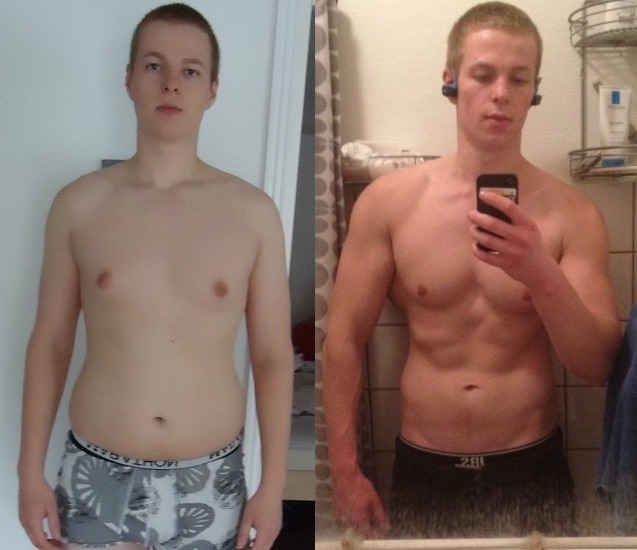
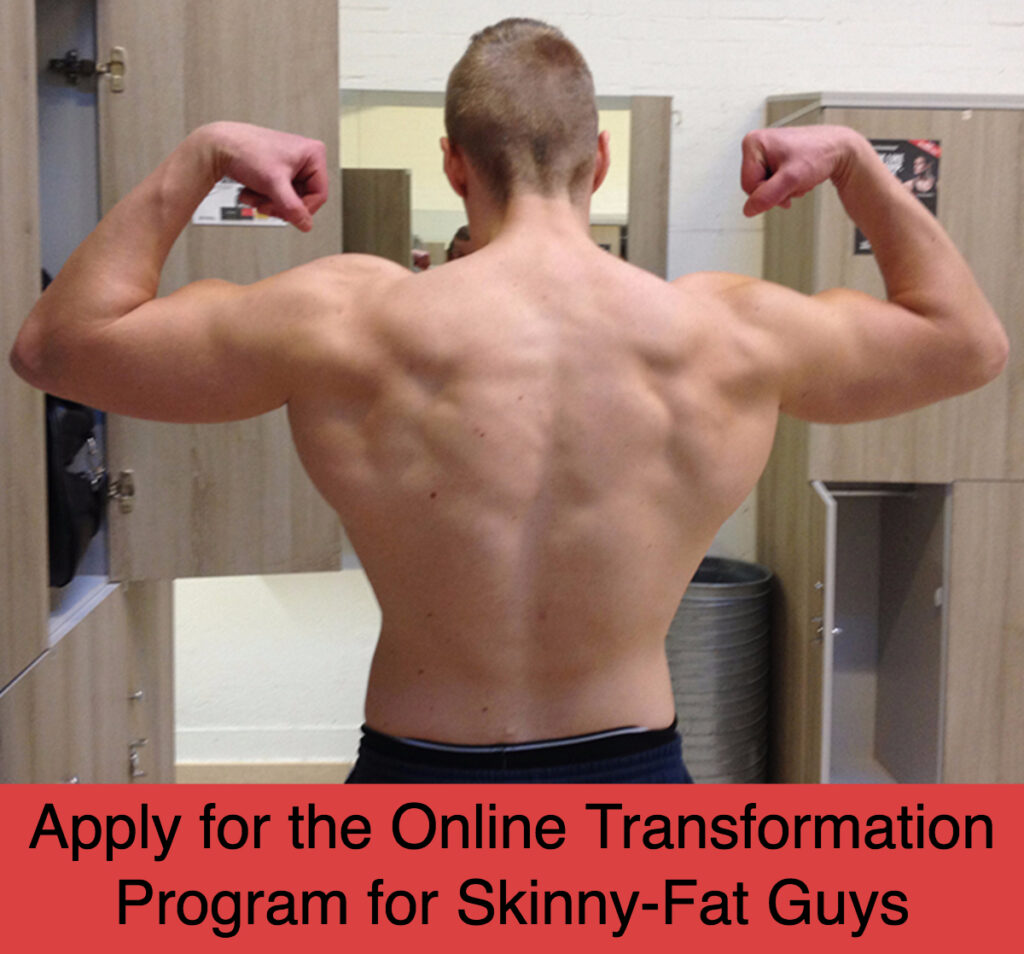
 Why you shouldn’t take aromatase inhibitors or estrogen lowering drugs, supplements or herbs
Why you shouldn’t take aromatase inhibitors or estrogen lowering drugs, supplements or herbs
Hello,
Would the cardio reccomendations in the article work if you have a specific sport(mid-distance/distance running) that requires you to do lots of cardio per week? I mainly do cardio for the sport. How would you approach lose fat from the skinny fat build, while not being a hardgainer and doing the huge amount of training.
Oskar,
I really don’t understand why you continue to attack strength training programs such as 5×5. I do not post this to disrespect as I do feel that the majority of your content is valuable. You’ve put out a lot of good info. But to say 5×5 won’t work for skinny fat is in my opinion disingenuous. The reality is anything can “work” including calisthenics, barbell training, etc, provided that progressive overload takes place. With barbell training it can take years to see dramatic changes, because someone can continue to get stronger for 15-20 years on the barbell lifts. But the root of my argument here comes from the fact that while you did make decent progress, the numbers you are reporting are in a range that show you simply have not built up enough objective experience with barbell training to have a realistic judgement on whether it works well or not. The numbers that you claim to have achieved are as follows:
Bench press: 66 LBS > 220 LBS
Squat: 66 LBS > 315 LBS
Deadlift: 105 LBS > 400 LBS
Overhead Press: 33 LBS > 154 LBS
While I wouldn’t call these numbers “weak” by any means, based on your body weight of ~200 lbs, most of your numbers are roughly what would be considered in the “beginner” stages of strength training (the deadlift and squat being borderline intermediate). I emphasize this because stages of training (beginner, intermediate, advanced) have nothing to do with time spent training, and have everything to do with weight on the bar. The latter is objective in nature, and thus more scientific.
Below are reasonable expectations one can achieve (2 years for intermediate goals, and 5 years for advanced goals).
For reference from Martin Berkhan:
“Strength Goals: Intermediate
Bench press: body weight x 1.2
Chin-ups or pull-ups: body weight x 1.2 or 8 reps with body weight.
Squat: body weight x 1.6
Deadlift: body weight x 2
Strength Goals: Advanced
Under the exact same conditions as the previous example, 3 out of 4 of the following goals should be reached within five years, along with all of the strength goals listed under “intermediate”:
Bench press: body weight x 1.5
Chin-ups or pull-ups: body weight x 1.5 or 15 reps with body weight.
Squat: body weight x 2
Deadlift: body weight x 2.5”
To be able to form a solid opinion on whether strength training works or not, you have to put in the time and effort and make dramatic improvements over a long periods of time. I was a “skinny-fat” guy and put in a good 4 years. For personal reference, I’m a 5’10” 200lb male. When I started I was a skinny-fat 165 lbs. I took my squat, bench, and dead lift from weak numbers to 485/320/500, respectively. And I am still improving. I get accused of being on steroids from time to time, which tells me that I have a decent physique. One of the most important muscle-building lessons I learned through this journey was that I didn’t start noticing drastic changes in muscle shape and appearance until I reached near advanced levels of strength. I won’t go into the research of why strength training is good for muscle growth. It’s too numerous to discuss, but can easily be observed throughout sports and exercise physiology literature.
Once again, I write this with due respect, and I don’t claim that other training methods (i.e. calisthenics, etc) don’t work. But you consistently write against strength training without the experience or evidence to back it up.
Thanks for your comment and it’s always interesting to see different point of views.
Your main argument behind doing heavy barbell lifts is that you need to get to the advanced level to start seeing progress in muscle mass.
If you train hard and consistently, reaching the advanced level takes 3-7 years of training depending on starting point and response to training.
Most people don’t want to go through 3-7 years of heavy training with a massive risk of injury just to look the same as a guy who lifts half the weight for higher reps and trained less than half their time.
The vast majority of skinny-fat guys on this site desperately want to pack on as much muscle mass as possible (especially on the upper body) while staying injury free and those who do not prioritize that first, most likely would read a strength training site rather than a body-transformation site.
Heavy barbell training is suboptimal for gaining muscle mass because as you said yourself, you have to pretty much get to the advanced level before you even look like you lift.
In addition, the heavy barbell exercises have a terrible stimulus to fatigue ratio. You get a lot of fatigue with minimal stimulus on the target muscles (delts, arms, lats, upper chest) for aesthetics.
Regarding your own progress: That’s great you succeeded with heavy barbell training from a skinny-fat base, however you’re certainly the exception to the rule.
In my own case, you mention that my numbers are around the beginner-intermediate stage. That’s a good point, however there are several things that have to be considered:
1) Starting strength and strength potential are largely determined by limb length and bone structure. People with very long limbs and small structures, won’t be able to get nearly as strong pound for pound as shorter, stockier guys as yourself. The guideline numbers don’t account for that.
2) I consistently trained with SS and MadCow 5×5 and later Berkhan’s reverse pyramid training for 2.5 years. All sessions were taken to failure with good technique and I found that no matter what I did, I would constantly plateau. The only way I could gain strength was by eating in a big surplus and getting fat. Then when I cut down, any strength gains I made went away. After being stuck at the same numbers for over a year I decided to try new ways to train. This is the typical experience for skinny-fat guys on strength programs.
3) Once I switched to higher rep training on bodyweight exercises, I was able to make progress consistently and I immediately saw muscle gains in the right places. I’ve trained this way for over 7 years now and built up to 13 wide grip pull ups, 30 diamond push ups and 25 dips at 260 LBS bodyweight. When I weighed around 200 LBS many years ago I could do my bodyweight x 1.5 for 5 reps and around 26 reps with bodyweight. Thus my strength levels on bodyweight exercises reached the advanced level.
4) The result in terms of muscle mass when training in the 7-30 rep range on bodyweight exercises, dumbbell exercises and cables has been far superior for me compared to the heavy barbell lifts. I’ve exceeded the max measurements for arms and chest circumference in the Casey Butt muscular potential formula and my legs, neck, calves and forearms are close to the max.
5) When I applied my own training techniques on clients who previously didn’t respond well to heavy barbell training, they saw much better results.
6) I’m not against weight training at all and my “bodyweight only” programs are for beginner only. Once a decent base has been built on bodyweight exercises, I have my clients do hybrid programs. However, these programs use mainly dumbbell and cable exercises because the stimulus to fatigue ratio is much better. There really is no reason to pound heavy bench presses, squats and deadlifts unless you want to build a massive lower chest, thighs and glutes. There are much better exercises out there if you train for aesthetics.
7) Does that mean that heavy barbell training is useless for muscle growth? No, any type of resistance training will lead to some muscle growth. However, there’s no doubt that: a) 7-30 reps is much better for muscle growth compared to 1-6 reps due to a much higher time under tension and mind muscle connection when doing longer sets. b) Heavy barbell training has a higher risk of injury compared to higher rep training, c) For the vast majority of skinny-fat guys, the “aesthetics muscles” (lats, upper chest, arms and delts) will not grow optimally from heavy squats, deadlifts, bench presses, overhead presses and rows and d) bodyweight, cable and dumbbell exercises done with higher rep schemes are much less fatiguing and provide more stimulus, thereby they can be done with higher frequency and volume which for most people will lead to more muscle growth long term.
Also, this is a good video by an elite powerlifter who advises you to train with at least 10 reps for optimal hypertrophy: https://www.youtube.com/watch?v=Xp5tf5-QSMM
Oskar,
Thanks for the reply. This is also why I respect your work so much. You are not afraid to stand up for your viewpoints. Just saw your email article on why you don’t think weight training is useless, but that you feel body weight training is more useful for beginners. I couldn’t agree more. One thing I will disagree on is that weight training is inherently dangerous.
I’ve never had any major injuries related to weight training despite consistent heavy training for years. I have been around power lifting for years and have rarely seen someone get injured while using correct technique. I have seen people get injured for lifting incorrectly, but mostly due to ego-lifting, or not learning how to properly execute the movements. Properly executed lifts with correct bracing and biomechanics virtually eliminates injury risk. I’m not saying that it can’t happen but it’s not likely. But this all requires time, education, and patience, which many people do not have. For most people, they are just not going to have the ability or drive to educate themselves or hire a coach to learn to lift correctly. And with that being said, I feel that for those people, body weight training is superior. And I will concede that even though proper weight lifting results in low injury rate, the injury rate for calisthenics is obviously going to be lower, virtually non existent.
Rep ranges is another point of contention, however. Have you seen Dr. Brad Schoenfeld’s research? I think the most anyone can say is higher reps are more efficient for muscle-growth, but volume-equated low (3-5) reps can be just as anabolic, as per what the research shows. The problem is doing a ton of sets takes 2-3x longer than lower sets and higher reps. Again, this is just a nuanced point, but one that I find important.
Your point about powerlifters using higher reps to train is accurate, too. They perform block periodization all the time. I use that myself as well to put on mass. I am not saying low reps are the best way to build muscle, far from it. 5×5 programs combined with calisthenics brought my strength levels up to good baseline levels and brought my body weight up to a lean 200#. I’ve since used block periodization to put on even more muscle and recomposition. So yes, more volume is great for muscle growth, but low reps can be effective too. Both low and high reps have their place and are good for breaking past plateaus.
Awesome article, it did clear many myths i believed in.
Hey Oskar. Most of your articles aren’t available to look at anymore. It says they are unavailable. Just letting you know.
That was an epic article. Thank you for that Oskar.
Great article Oskar, I was just wondering, are your arms just a little soft without flexing because mine are even though they have been getting firmer.
Hey Oscar,
Great article, as usual. What I am curious about is – are you still living in the Bangkok? I follow you on Instagram and you share a lot of stories from the Bangkok, or I am just being mistaken? What led you to move?
Thanks for reply,
Michal
Hi Oscar
Good article but dies it all apply if you are just skinny without having any fat ? My legs are too thin and do need bulking and my shoulders too .
Would I be better off with a hardgsiners programme ( press / squats/ deadlifts etc) ?
Is tour programme just for skinny FAT only ?
Hello, I have seen Oscar reply to this question before and yes, it will work for the skinny ectomorph too.
Hey Oskar,
I do 6 sets of chin ups every Mon-Wed-Fri. However my max chin ups seem to have stalled at 7 reps and I seem unable to add even a single rep to my max. I don’t think that it is due to having excess bodyfat as I am still losing weight steadily every week. I have tried deloading and also refeeds and diet breaks but my chin ups seem to have plateaued. How do I break the barrier to reach 20 reps from 7 reps?
Your best article ever.